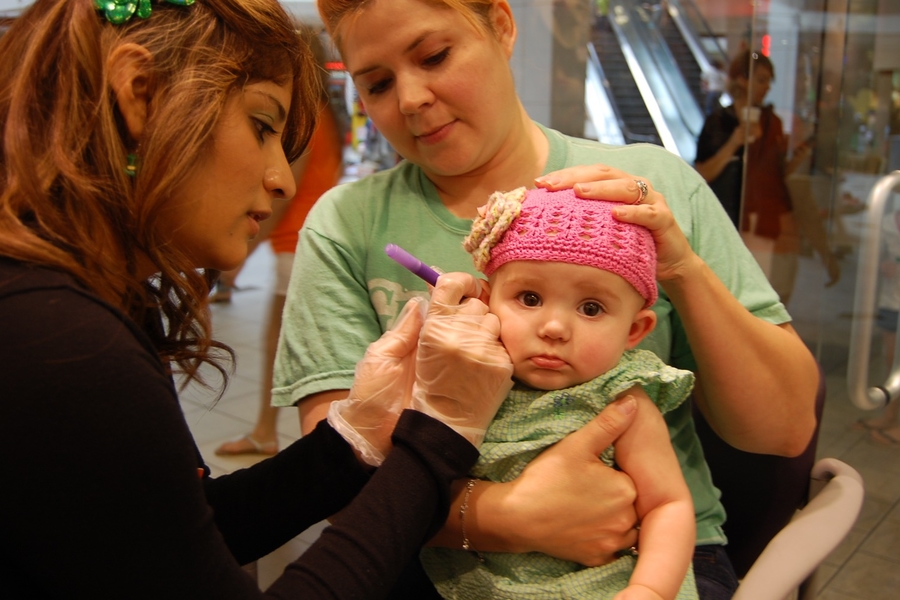
Precautions To Be Taken While Getting Baby’s Ear Pierced
28 Feb 2018 | 4 min Read
Babychakra
Author | 1369 Articles
Mothers, take note before doing infant ear piercings.
Ear piercings have been carried out since biblical times, and are a common practice even today. In certain societies, even boys have their ears pierced during infancy. In spite of this, it is a difficult decision for the parents due to the pain it causes to the child. Many experts are in fact, against ear piercings of new-borns, some considering it a form of cruelty. However, if you must, the entire process can be made a lot easier with the following tips.
At what age should I get my kids ear piercing done?
As per the American Academy of Paediatrics (AAP), there is no particular age to get a child’s ears pierced. Irrespective of the age, ear piercings are quite safe as long they are done hygienically, and correctly. Some parents get their infant’s ears pierced as early as when the baby is just 12 days old while some wait until the baby’s first birthday.
AAP advises to wait until the child is mature enough to take care of pierced ears, which translates to two to three years approximately. This can be considered the correct age to get ear piercings done as the child is old enough to understand language and instructions. Moreover, the skin of the ear is still soft but not as delicate as earlier. Also, by that age, major immunizations would have been done, which further minimizes chances of infections.
Where to get ears pierced?
Some parents prefer getting their baby’s ears pierced at their local jeweller, whilst some prefer to visit a medical practitioner who performs these procedures. However, there is no restriction, provided the person is experienced and performing it under aseptic conditions.
Ear piercings are different for infants and adults in some respects. Hence, keep in mind the following tips:
- Ensure that all instruments used during the procedure are sterile.
- Do some research and find a place or practitioner of good reputation.
- Higher preference should be given to medical professionals who practice ear piercings, as they are well aware about medical guidelines.
What is the procedure for infant ear piercing?
The procedure is very similar to that of adults.
- Step 1: The area is cleaned with alcohol or an antiseptic. For maintaining strict hygiene, the professional should wear surgical gloves.
- Step 2: Piercing is done either with a needle or an ear piercing gun. It depends on the professional’s recommendation as well as the parent’s preference. Both lead to pain but only during the process of piercing which lasts for 1-2 seconds.
- Step 3: Earrings are then placed within the hole to prevent it from closing. Gold is generally preferred as the material of the earring, as it is less likely to cause infections. Gold plated earrings can also be used.
- Step 4: Disinfectant is usually applied twice a day for a week. It is recommended to shift earrings from one ear to another each week for the next six to eight weeks.
The best place to pierce baby ears is the bottom ear lobe. Areas other than this are not meant for piercings during childhood, and not recommended by paediatricians.
What precautions should be taken after ear piercings are done?
- Swap earrings every week from one ear to another. Clean the earring after it is removed each time with a disinfectant.
- Before tending to the pierced area, always wash and dry your hands thoroughly.
- Apply some disinfectant twice a day for 6 to 8 weeks to avoid infection. Wash the baby’s ears with baby-safe soap.
- Make the baby wear clothes that can be removed easily to avoid tugging at the ears.
Also read: How should you go about piercing your child’s ear?
A


Related Topics for you
Suggestions offered by doctors on BabyChakra are of advisory nature i.e., for educational and informational purposes only. Content posted on, created for, or compiled by BabyChakra is not intended or designed to replace your doctor's independent judgment about any symptom, condition, or the appropriateness or risks of a procedure or treatment for a given person.
